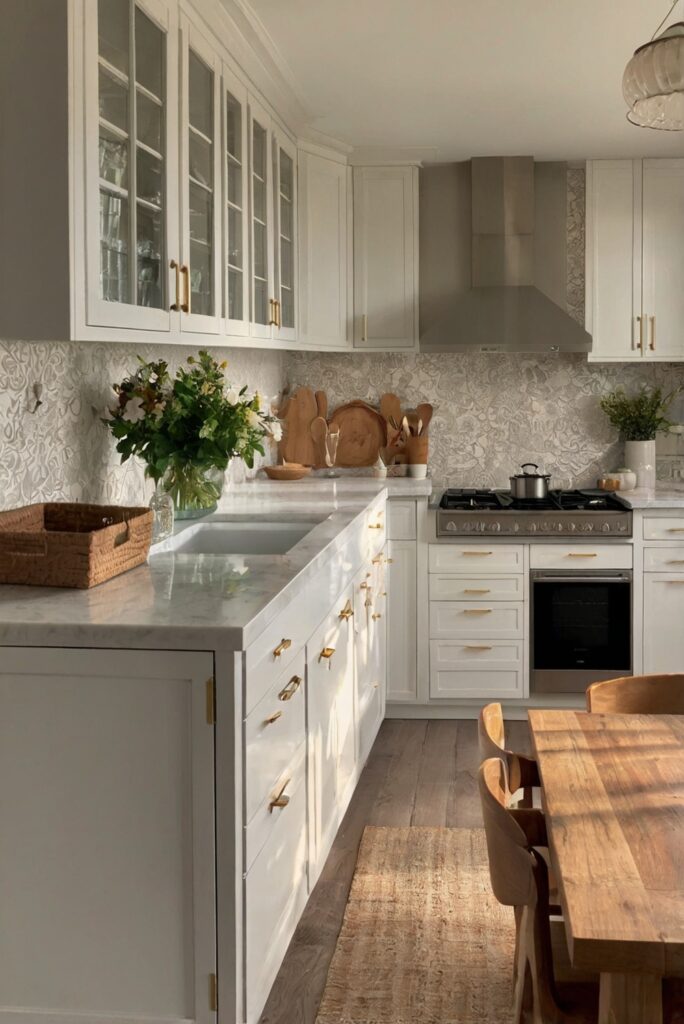Discover the essential steps to create a sleek minimalist kitchen with handleless cabinets. Elevate your interior design routine with this stylish trend.
To design a minimalist kitchen with handleless cabinets, start by decluttering and keeping only essential items. Opt for a neutral color palette to create a clean and streamlined look. Incorporate built-in appliances to save space and maintain a seamless aesthetic. Utilize smart storage solutions such as pull-out drawers and hidden compartments to keep the kitchen organized. Consider adding under-cabinet lighting for a modern touch and better functionality. Ensure proper space planning to optimize the kitchen layout and functionality. Choose high-quality materials for your cabinets and countertops for durability. Keep the design simple and minimalist, focusing on clean lines and uncluttered surfaces for a sleek and contemporary look.
Create a cohesive design by matching the color scheme with the rest of your home interior. Consider hiring a professional interior designer for expert advice and guidance. Experiment with different textures and finishes to add visual interest without overwhelming the space. Regularly maintain and clean your kitchen to preserve its minimalist look and functionality. Incorporate natural elements such as plants or wood accents to bring warmth and character to the space. Pay attention to details such as paint colors and wall finishes to achieve a cohesive and harmonious look throughout your home. Stay organized by assigning designated areas for specific items and following a daily routine to keep the kitchen clutter-free.
How to Design a Minimalist Kitchen with Handleless Cabinets?
1. Start with a Clear Vision
To design a minimalist kitchen with handleless cabinets, it is crucial to start with a clear vision of the space you want to create. Consider the functionality and aesthetics you desire for your kitchen. The key to minimalist design is simplicity and clean lines.
2. Choose Handleless Cabinets
Handleless cabinets are a hallmark of minimalist kitchen design. They create a sleek and seamless look by eliminating the need for visible handles or knobs. Opt for handleless cabinets with push-to-open mechanisms for a clean and modern finish.
3. Opt for Neutral Colors
Neutral colors such as white, grey, beige, or black are ideal for creating a minimalist kitchen. These colors create a timeless and sophisticated look while promoting a sense of calm and serenity in the space.
4. Focus on Functional Layout
When designing a minimalist kitchen, focus on creating a functional layout that maximizes space efficiency. Consider the work triangle (the relationship between the stove, sink, and refrigerator) to ensure a smooth workflow in the kitchen.
5. Incorporate Clever Storage Solutions
To maintain the minimalist aesthetic in your kitchen, incorporate clever storage solutions such as pull-out drawers, hidden cabinets, and vertical storage options. These will help keep clutter at bay and maintain the clean lines of your design.
When designing a minimalist kitchen with handleless cabinets, remember that less is more. Focus on simplicity, clean lines, and functionality to create a space that is both visually appealing and practical. By following these tips, you can achieve a minimalist kitchen design that is both stylish and efficient.
In conclusion, designing a minimalist kitchen with handleless cabinets requires careful planning and attention to detail. By starting with a clear vision, choosing handleless cabinets, opting for neutral colors, focusing on a functional layout, and incorporating clever storage solutions, you can create a sleek and modern kitchen that embodies the principles of minimalism. Consider consulting with a professional designer to help bring your vision to life and ensure that every element of your kitchen design aligns with your desired aesthetic.
What are handleless cabinets in a minimalist kitchen?
Handleless cabinets in a minimalist kitchen are sleek and modern storage solutions that do not have traditional handles or knobs. Instead, they feature integrated grooves or push-to-open mechanisms for easy access. This design choice creates a clean, seamless look that enhances the minimalist aesthetic of the kitchen.
Why choose handleless cabinets for a minimalist kitchen?
Handleless cabinets are an excellent choice for a minimalist kitchen because they contribute to a streamlined and clutter-free appearance. Without handles, the cabinets blend seamlessly into the overall design, creating a visually cohesive and calming space. Additionally, handleless cabinets are easier to clean and maintain, making them a practical and stylish choice for a modern kitchen.
How to incorporate handleless cabinets into a minimalist kitchen design?
When designing a minimalist kitchen with handleless cabinets, consider the following tips:
– Choose high-quality materials like matte finishes or wood veneers for a sophisticated look.
– Opt for integrated appliances to maintain a seamless appearance.
– Use light colors and minimalistic hardware to enhance the clean aesthetic.
– Incorporate ample storage solutions to keep the space clutter-free.
– Consider adding a pop of color or texture to create visual interest in the space.
What are the benefits of a minimalist kitchen design?
A minimalist kitchen design offers several benefits, including:
– Improved functionality and organization.
– Enhanced visual appeal and a sense of spaciousness.
– Reduced clutter and easier maintenance.
– Timeless and versatile design that complements various styles.
– Sustainable practices by focusing on essential items and reducing waste.
What are some popular minimalist kitchen trends with handleless cabinets?
Some popular minimalist kitchen trends featuring handleless cabinets include:
– Monochromatic color schemes for a clean and cohesive look.
– Incorporating natural elements like wood or stone for warmth.
– Open shelving to showcase curated items and maintain an airy feel.
– Statement lighting fixtures to add visual interest and focal points.
– Smart storage solutions for efficient use of space and organization.

